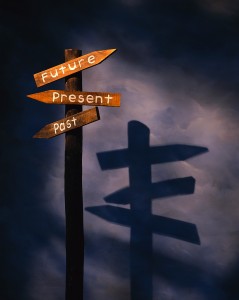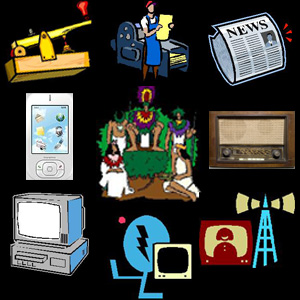On May 1, I attended a panel discussion among five stellar thinkers on the subject of the future of journalism. The gathering took place at Baruch College’s Engelman Recital Hall in New York City. The hall was almost filled to capacity and expectations were high that the “subject experts” would articulate a vision of journalism’s future that would clarify for those in attendance what’s next for the so-called Fourth Estate.
What became clear as the conversation evolved was that the speakers themselves were struggling to define the future. The overall impression they projected, their collective expertise notwithstanding, was that they really didn’t have a clue.
Prognosticating the future is a tricky business. Horoscopes and psychics lay claim to such visions of what’s coming—and enough religionists have mistakenly called for the end of the world numerous times; it can be an entertaining pursuit. The past can certainly be prologue, but as the recent real estate boom and bust scenario underscores, just because something goes in one direction for a time doesn’t mean it will always go in that direction. Nothing lasts forever.
With these precautions in mind, here’s my thinking on the subject of the future of journalism. In this blog installment I’ll take a look back and in the following blog attempt to extrapolate forward.
Journalism’s Journey
 Journalism is about news, information, and analysis that affect the individual, the family, the community, the region, the nation, and the world. People have needed news, information, and analysis ever since the species Homo sapiens has walked the earth. It is as important as food, shelter, and sex. People have a need to know what’s going on around them, and to understand the impact on their living context.
Journalism is about news, information, and analysis that affect the individual, the family, the community, the region, the nation, and the world. People have needed news, information, and analysis ever since the species Homo sapiens has walked the earth. It is as important as food, shelter, and sex. People have a need to know what’s going on around them, and to understand the impact on their living context.
The central issue is this: journalism is about who gets to know about who, what, when, where, how, and why. What impacts this model is “how” the information is conveyed. What is different over time and what is at the heart of journalism’s impact is “how” news is delivered and the characteristics of that “how.”
In pre-historic times news/information was all “oral”—word of mouth, face-to-face. Imagine the old man of the tribe telling the stories of the tribe to the gathered members around the campfire. The implications of this “news” environment are that you had to be there to “hear” the stories and the news. If you weren’t there to hear it, you missed it. And if you didn’t speak the same language as the tribal members, you wouldn’t understand it.
Then early writing came along around 5,000 BC and people could make marks on all manner of materials (e.g., clay) leading to records of events and transactions. But you had to know how to read those markings and if you also knew how to make those marks, you had a job: you could be a scribe, or a religious or military leader, or a merchant.
Then along comes Caesar who invents the “acta diurna,” the daily news in Rome. This hand-written document contained news and information not that much different from today’s New York Daily News. In 1455 AD. Guttenberg introduces the movable type printing press and suddenly news and information can be “mechanically” reproduced faster than a priest could write “In the beginning. . .” in Latin, of course. It can be argued the printing press obsolesced “the town crier,” an interim conveyor of local news.
 In 1844 Samuel B. Morse commercially introduces the telegraph, stating “what hath God wrought?” (Interesting how God seems to pervade the news and information business). News and information could now travel at the speed of light. And in 1968 the United States military develops an electronic system as a counter to a possible Soviet missile attack. This system, known as DARPANET, evolves into the Internet, and when CERN’s Lee-Berners invents graphics capabilities to go along with the “text” capabilities, the World Wide Web is born. The news, information, and analysis business hasn’t been the same since.
In 1844 Samuel B. Morse commercially introduces the telegraph, stating “what hath God wrought?” (Interesting how God seems to pervade the news and information business). News and information could now travel at the speed of light. And in 1968 the United States military develops an electronic system as a counter to a possible Soviet missile attack. This system, known as DARPANET, evolves into the Internet, and when CERN’s Lee-Berners invents graphics capabilities to go along with the “text” capabilities, the World Wide Web is born. The news, information, and analysis business hasn’t been the same since.
In between all this, of course, is the evolution of newspapers, magazines, books, the telephone, film, radio, broadcast and cable television, satellites, computers, CDs, DVDs, holography, cell phones, I-phones, Kindles, Nooks, and a thousand other technologies that provide people all over the world with news, information, and analysis.
One of the concepts I learned from a Sociology 101 class many years ago is this: whoever is at the center of the information flow is at the center of power. In the context of this blog, this means that when all news and information was oral, the speaker was at the center of power. When all news and information required the ability to read and write, those who could read and write were at the center of power. Those who had access to the printing press, and who could read and write, these were the people at the center of power. Those who had the financial means and political connections to start newspapers, magazines, radio stations, television stations, and cable networks, those people put themselves at the center of power. Today’s access to the Internet and those who know how to create a web site presents a transformative situation. Today, anyone with access and the knowledge can create a web site or blog and purvey news, information, and analysis, including myself.
Over several millennia, news, information, and analysis have become increasingly democratized. In the last hundred years electronic devices that purvey news and information of all kinds can leap over geographic, religious, and political boundaries in a nanosecond. More and more people globally are gaining access to news and information. It has led to and is instigating change: witness the fallout from 1989’s Tiananmen Square and the more recent, so-called “Arab Spring.”
But it is not all good news. According to UNESCO figures, about one-sixth of the world’s adult population (mostly women) are illiterate, and all appearances to the contrary, two-thirds of the world’s population still does not have access to the Internet as of the end of 2011, according to www.internetworldstats.com.
The model of who gets to know about who, what, when, where, how, and why is at heart of the matter. Clearly, there is a future for journalism. And there is a future for journalists—people who know where to go to get information for a story, who can abstract that information and analyze it into a cohesive story, who can convey it in language and a style that reaches an audience, and who can do all this with regard to the character of the news medium (the “how”) involved.
At its core, it’s still about telling the stories of the tribe. We still gather around the metaphorical campfire to listen to these stories. What has changed is that our “news” context is both global and local. And how we get this information is increasingly electronic. There are many more issues to be addressed, however, such as: have journalism ethics touched new lows in the last few years? Going forward are newspapers really on their way out? Who owns the media anyway? And the alleged democratic character of electronic news media notwithstanding, do we really get all the news that’s fit to print or are we consuming news and information as entertainment as a way of amusing ourselves to death?
Where is Journalism Going?
More in the next blog.
Eugene Marlow
May 7, 2012
© Eugene Marlow 2012


![Building hte future[1]](http://www.eugenemarlow.com/wp-content/uploads/2012/05/Building-hte-future1-300x209.jpg)